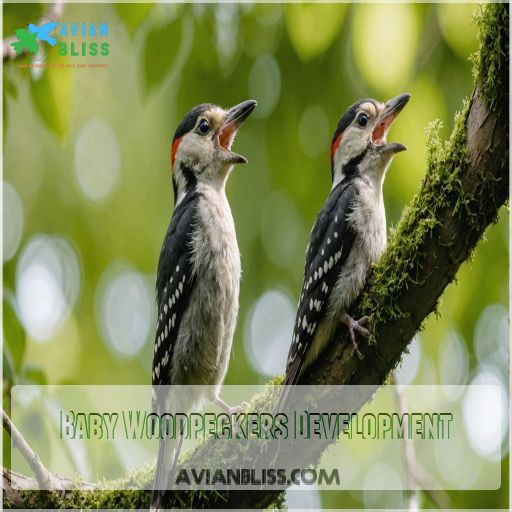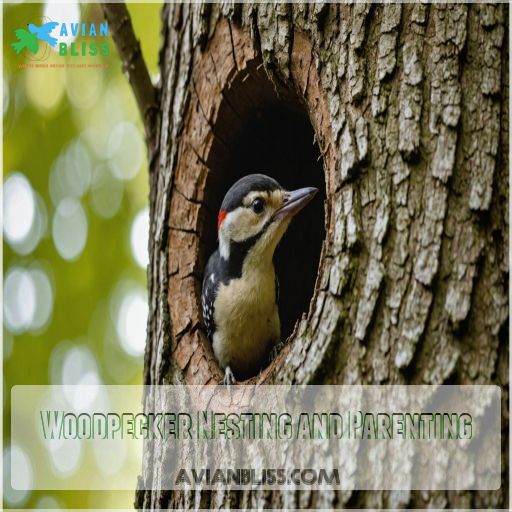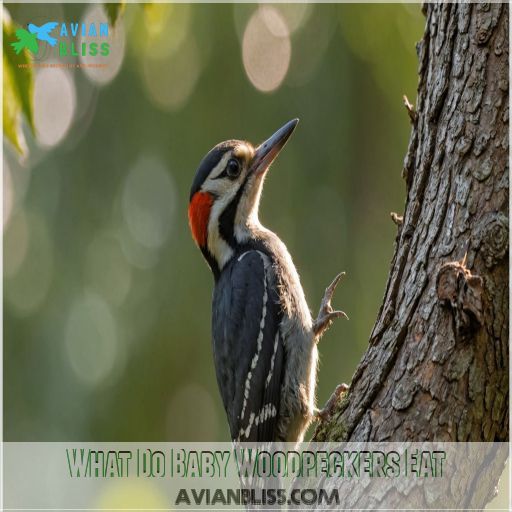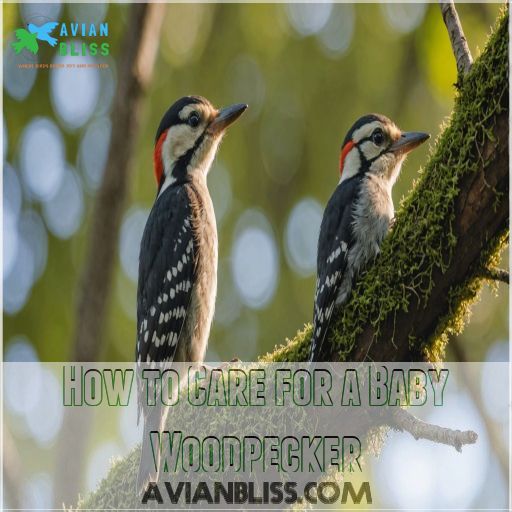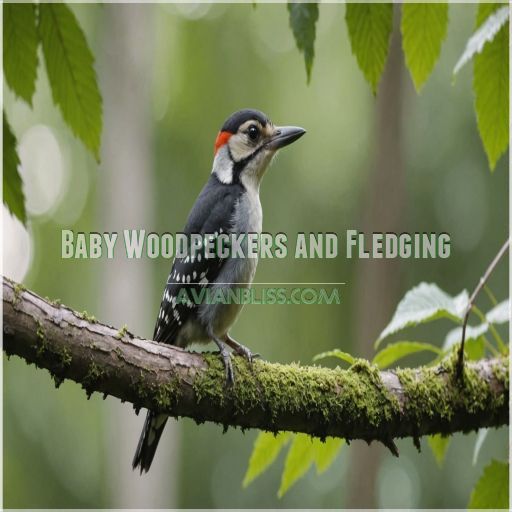This site is supported by our readers. We may earn a commission, at no cost to you, if you purchase through links.
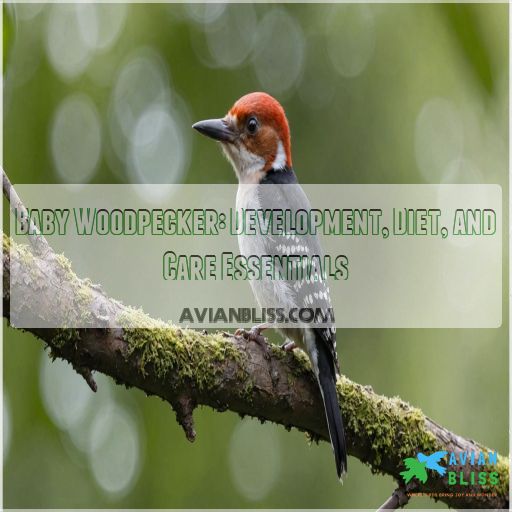 When you spot a baby woodpecker, you’re in for a treat! These adorable fledglings look nothing like their parents at first, hatching naked and blind.
When you spot a baby woodpecker, you’re in for a treat! These adorable fledglings look nothing like their parents at first, hatching naked and blind.
But don’t worry, they grow up fast! In just three weeks, they’ll transform from helpless hatchlings to curious explorers.
Both mom and dad pitch in, working tirelessly to feed their hungry brood every 15-30 minutes. Talk about a full-time job!
As they grow, baby woodpeckers develop soft, downy feathers and those signature red caps. Their beaks may be small, but they’re already built for pecking.
Nature’s little drummers are full of surprises, and their journey from nest to tree is quite the adventure.
Table Of Contents
- Key Takeaways
- Baby Woodpeckers Development
- Woodpecker Nesting and Parenting
- What Do Baby Woodpeckers Eat
- Feeding a Baby Woodpecker
- Woodpecker Eggs and Incubation
- Baby Woodpeckers Identification
- How to Care for a Baby Woodpecker
- Baby Woodpeckers and Fledging
- Finding a Baby Woodpecker
- Woodpeckers Specialized Features
- Frequently Asked Questions (FAQs)
- What makes woodpecker chicks special?
- Can a baby woodpecker fly?
- What do woodpecker babies look like?
- How long does a woodpecker incubate?
- What do baby woodpeckers look like?
- What does a juvenile woodpecker look like?
- What to do if you find a baby woodpecker?
- How long do baby woodpeckers stay with their parents?
- Why do some baby woodpeckers appear bald?
- How to discourage woodpeckers from nesting in houses?
- Can baby woodpeckers be rescued and hand-raised?
- Do baby woodpeckers make distinctive sounds?
- How do starlings affect baby woodpecker survival?
- Conclusion
Key Takeaways
- You’ll be amazed at how quickly baby woodpeckers develop – they go from naked, blind hatchlings to curious explorers in just three weeks. It’s like nature’s own fast-forward button.
- Don’t be fooled by their tiny size – baby woodpeckers have some seriously cool adaptations. Their zygodactyl feet (two toes forward, two back) are like built-in rock climbing gear, letting them cling to trees like little feathered Spider-Men.
- If you stumble upon a baby woodpecker, resist the urge to play bird mom. Unless it’s visibly injured, it’s best to leave it be – those invisible woodpecker parents are usually nearby, running their own avian flight school.
- Feeding a baby woodpecker is like running a 24/7 bug buffet. These hungry little drummers need protein-packed meals every 15-30 minutes from sunrise to sunset. Talk about a full-time job for woodpecker parents!
Baby Woodpeckers Development
In "Baby Woodpeckers Development," you’ll discover how these little drillers grow from funny fluffballs into skillful flyers.
With unique color patterns and evolving behaviors, baby woodpeckers are like tiny power tools learning to find their groove in the forest.
Physical Characteristics of Baby Woodpeckers
Imagine a tiny fluff ball with a spunky attitude—yep, that’s your classic baby woodpecker.
These little chicks typically boast a soft, downy plumage that later reveals their species-specific feather patterns.
Their beaks are short but sturdy, gearing up for serious pecking. And those eyes? Expect big, curious peepers taking in the world, with big, curious peepers.
Behavioral Traits of Baby Woodpeckers
Once you’ve marveled at a baby woodpecker’s adorable fuzz, let’s chat about their charming antics.
They’re quite the busybodies, engaging in:
- baby woodpecker calls echoing through the trees
- Nestling behavior involving incessant begging from parents
- Fledgling development, like awkwardly hopping to follow woodpecker parents
- Social interactions between juvenile woodpeckers, forming little, pecking playgroups .
Baby Woodpeckers Color Patterns and Markings
Juvenile woodpeckers sport different color variations and markings from adults, often sporting red caps atop their heads for added flair.
These camouflage patterns help them blend into their environments while they master bird behavior.
As they mature, these differences fade, revealing more typical adult plumage. It’s like their own bird-style transformation—a quirky twist on growing up in the avian fashion world. This change is a notable part of their development, signaling the end of their juvenile stage and the beginning of adulthood, marked by a more subdued adult plumage. .
Baby Woodpeckers Growth Rate and Development Stages
As you watch baby woodpeckers grow, you’ll notice rapid changes—like a caterpillar turning into a butterfly.
Typically, a baby woodpecker’s size and development are fascinating:
- Hatchling: Tiny, eyes closed.
- Nestling: Eyes open, fluffy down appears.
- Fledgling: Awkward flights begin.
- Key adaptations: Strong, sturdy beaks.
- Parent-fledgling interactions: Constant guidance and care.
Woodpecker Nesting and Parenting
You’ll find that woodpeckers are dedicated parents, with both mom and dad taking shifts incubating eggs and caring for their young.
They build cozy homes in hollowed trees or even cacti, providing a safe nest while the little ones learn life’s essentials.
This family bonding experience proves that teamwork really makes the treehouse work!
Types of Nests and Nesting Locations
Woodpecker nests are a cozy twist on the minimalist lifestyle: a bare wooden cavity without fancy nest materials.
These skilled carpenters chisel their homes into large, often diseased trees, favoring snags for easy excavation.
Nest placement varies, with strategic choices to thwart predators. Some species, like the Red-headed Woodpecker, even reuse their nest cavity annually (Source).
Role of Both Sexes in Incubation and Parenting
Woodpecker parenting is a true team effort. Both mom and dad share the load, taking turns to keep their eggs cozy and their chicks well-fed.
- Tag-team incubation shifts
- Dad’s daring nest defense maneuvers
- Mom’s masterful food-sharing techniques
- Joint chick-care duties, from feeding to feather-fluffing
You’ll find these feathered families working in perfect harmony, proving that with raising baby woodpeckers, two beaks are better than one!
Baby Woodpeckers Dependence on Parents
Nestled in their cozy tree cavities, baby woodpeckers rely heavily on their parents. You’d be amazed at how these tiny creatures depend on mom and dad for everything!
| Age (days) | Food | Warmth | Protection |
|---|---|---|---|
| 0-7 | 100% | 100% | 100% |
| 8-14 | 100% | 80% | 100% |
| 15-21 | 90% | 50% | 90% |
| 22-28 | 70% | 20% | 80% |
Talk about a full-time job for woodpecker parents!
Parent Woodpeckers Teaching Fledglings Survival Skills
As fledglings leave the nest, parent woodpeckers kick into high gear, teaching their young the ropes of survival.
You’ll see them demonstrating foraging techniques, like how to tap into anthills for a tasty snack .
They’ll also show off predator avoidance tricks and communicate through calls that keep the family together.
It’s like woodpecker boot camp, complete with lessons on finding the perfect nest site and mastering those tricky flight skills!
What Do Baby Woodpeckers Eat
If you’re wondering what baby woodpeckers eat to grow big and strong, let’s explore the dietary needs of baby woodpeckers.
Discover how you can help if you ever find yourself caring for one of these adorable peckers-in-training.
Natural Food Sources for Baby Woodpeckers
In the wild, baby woodpeckers feast on nature’s buffet. You’ll find these little peckers chowing down on a smorgasbord of insects and their larvae, which pack a protein punch perfect for growing birds.
As they develop, they’ll branch out to include berries, fruits, and seeds in their diet.
It’s like a tiny woodpecker food festival, with each bite helping them become the drumming masters we all recognize and admire.
Dietary Needs and Requirements of Baby Woodpeckers
Woodpecker chicks need a varied nutrient-rich diet to grow strong, much like how their parents thrive on a diet of tree sap and insects. They enjoy a mix of insects and fruits, which helps them develop the necessary adaptations for their unique feeding habits.
- Insects: Mealworms and other insect larvae provide protein and fats.
- Berries: Offer vitamins and sugar, delighting their taste buds.
- Nuts: Supply essential fats for brain development, though managing those tiny beaks can be nuts!
Human Care for Baby Woodpeckers and Diet Options
You’ve stumbled upon a baby woodpecker, huh? Here’s the scoop: feed it mealworms or insects since they’re packed with the good stuff it needs—think of it as nature’s protein shake.
Feed every daylight hour. But don’t go solo; call a bird rescue for expert help.
| Type | Frequency | Method | Notes |
|---|---|---|---|
| Mealworms | Every hour | Small pieces by hand | Provides hydration too |
| Insects | Frequently | Use a tweezer or spoon | High protein for growth |
| Bird Mix | When needed | Use tweezers carefully | Nutritional supplement |
| Rescue Help | ASAP | Phone or visit | Essential for long-term care |
Remember, you’re not alone in this rescue mission! .
Feeding a Baby Woodpecker
Feeding a baby woodpecker can feel like running a tiny bird café, where you’re the chef responsible for concocting high-protein meals every 15 to 30 minutes from sunrise to sunset.
You’ll need to focus on offering a nutritious menu using mealworms or similar soft foods that mimic their natural diet.
All while ensuring everything’s served at room temperature for their delicate digestive systems.
Suitable Foods for Baby Woodpeckers
For a baby woodpecker’s diet, think variety! Mealworm alternatives like mashed insects and berries are great.
These fledglings have unique nutritional needs that require frequent feedings to help them grow strong.
Just steer clear of harmful foods like bread and milk—these don’t fly in their world! Remember, a growing woodpecker appreciates a well-rounded menu.
Recipe for Baby Woodpeckers
Got a tiny woodpecker peeping for food? Think of mealworm mix as their baby formula, packed with protein for strong growth and development.
In fact, protein-rich foods, like mealworms, are essential for developing muscles and should be a staple in their diet.
Whip up a delightful homemade woodpecker food to keep those beaks happy.
- Blend unsalted nuts with dried insects
- Mix in mealworms
- Add a dash of peanut butter
- Stir in oatmeal for texture
- Finish with cornmeal
Bon appétit, feathered friend!
Feeding Frequency and Schedule for Baby Woodpeckers
In feeding baby woodpeckers, balance is key.
Aim for every 30-45 minutes during daylight hours, similar to a mealworm schedule, ensuring their growing needs are met.
While hand-feeding tips are valuable, it’s also a learning dance—like teaching them to salsa with pancakes!
Remember, their diet mimics their parents: insects and grubs .
Tips for Feeding a Baby Woodpecker
Feeding a baby woodpecker can be as intriguing as a mystery novel. Make sure you’re meeting its nutritional needs with a reliable feeding schedule. Use syringe feeding for easy handling and keep water concerns in mind.
- Offer softened cat food or insect paste.
- Avoid fishing worms.
- Consult a local wildlife expert for advice.
Woodpecker Eggs and Incubation
Woodpeckers are dedicated parents, with both mom and dad taking turns incubating their eggs.
From carefully selecting the perfect nesting spot to carefully crafting their cozy home, these hardworking birds make sure their little ones get the best start in life.
Incubation Period of Woodpeckers
Woodpecker eggs, shining like tiny pearls, generally take about 12 days to hatch, depending on species.
Nest site selection is important, preferring large trunks or limbs, often from trees with heart rot, a woodpecker’s delight.
Each species showcases variation in egg size, reflecting adaptability. A little patience helps successful incubation, leading to a bustling family of pecking chicks.
Role of Both Sexes in Incubation
Think of woodpeckers as the ultimate dream team.
When it comes to incubation shifts, both sexes pitch in. Males and females work together to make sure:
- Daytime cooperation: Both take turns warming eggs.
- Nighttime duty: Males often hold the fort.
- Shared parenting: Both handle egg care and nest defense.
- Egg warming techniques: Their skills are outstanding partners .
Nest Preparation and Nesting Materials
Imagine a cozy woodpecker nursery tucked inside a tree.
Birds choose nest locations in dead trees, ensuring the perfect nest cavity size and success . They love sturdy yet soft wood types for drilling.
Woodpeckers prefer natural nesting materials like wood chips over tiny pillows.
Here’s a fun table:
| Material | Function |
|---|---|
| Wood Chips | Cushion |
| Dead Trees | Structure |
| Soft Wood | Easy Carving |
Baby Woodpeckers Identification
When it comes to woodpeckers, identifying the little ones can be a delightful challenge.
As these juveniles grow, their color patterns change, making them look more like their feathered parents but leaving room for some entertaining mix-ups, as baby woodpeckers sport long bills and strong legs with some sporting temporary flashy red caps.
Physical Characteristics for Identification
After eggs crack open, spotting baby woodpeckers isn’t tricky but it can feel like a game of bird hide-and-seek.
Their beak size matches their tiny frames, while feather patterns emerge resembling adult colors .
Note their stubby legs and curious eye colors beneath fuzzy heads. Those early head markings might seem unfinished but are already full of personality.
Differences Between Juvenile and Adult Woodpeckers
Juvenile woodpeckers contrast with adults in several features.
While adult plumage is more vibrant and smooth, juveniles sport shaggier crests and muted colors. Their beaks may appear slightly smaller.
Behaviorally, juvenile woodpeckers often exhibit more playful tendencies and less refined foraging skills. Over time, these youngsters refine their habits and adapt to favored habitats .
Temporary Characteristics of Juvenile Woodpeckers
As baby woodpeckers grow, their plumage transforms.
Their juvenile birds sport a red cap, unlike adults, and their feathers may appear shaggy or disheveled. These temporary traits help fledglings blend in with their surroundings and avoid predators.
Over time, their beaks strengthen, and their feathers become sleeker, signifying their shift to adulthood. Observing these changes is part of the joy of watching these dynamic birds mature.
How to Care for a Baby Woodpecker
Caring for a baby woodpecker can feel like running a 24-hour café for tiny, feathered customers, but it’s essential for their well-being.
Make sure you create a cozy environment, keep everything squeaky clean, and keep a close eye on the little one’s health to make sure they’re thriving.
Providing Proper Environment and Housing
Creating a cozy home for a baby woodpecker isn’t rocket science. Just follow these tips:
- Nest Box Design: Select a sturdy box with a snug entry hole to replicate a natural tree cavity .
- Suitable Materials: Line with sawdust or wood shavings—no fluff here, please!
- Temperature Control: Keep it warm but not sizzling, just like Goldilocks’s porridge!
Maintaining Proper Hygiene and Cleanliness
A clean nest is a happy nest! When caring for a baby woodpecker, maintaining proper hygiene is really important.
| Task | Frequency | Tips |
|---|---|---|
| Clean feeding tools | After each use | Use mild soap, rinse thoroughly |
| Disinfect housing | Daily | Avoid harsh chemicals |
| Change bedding | As needed | Use unscented materials |
| Check for parasites | Weekly | Look for tiny moving specks |
| Wash hands | Before and after handling | Prevents disease spread |
Remember, a tidy environment is key to your little drummer’s wellbeing!
Monitoring Baby Woodpeckers Health and Well-being
After ensuring your baby woodpecker’s environment is spick and span, it’s time to keep a watchful eye on its health.
You’ll want to monitor your feathered friend’s appetite, energy levels, and overall appearance daily. Watch for any changes in eating habits or unusual behavior – these could be red flags .
Regular weigh-ins can help track growth, and don’t forget to check those developing feathers for any signs of damage or parasites, monitoring the bird’s overall appearance and energy levels.
Baby Woodpeckers and Fledging
You’re about to witness one of nature’s most fascinating changes.
Baby woodpeckers taking their first flights is an exciting phase of life.
As these young birds prepare to leave the nest, the important role parents play in guiding their fledglings through this experience.
You’ll discover the value of parental guidance as these young birds navigate through this stage of life.
Signs of Fledging in Baby Woodpeckers
You’ll often spot tell-tale signs when your baby woodpecker is ready to fledge. Watch for these key behaviors:
- Increased wing flapping and exercising
- Peeking out of the nest cavity more frequently
- Attempts at climbing or perching near the nest entrance
These little acrobats are gearing up for their big debut! As they build strength and confidence, you might catch them practicing their "woodpecker stance" on nearby branches.
Parental Care After Fledging
Once out of the nest, young woodpeckers aren’t left high and dry. Their parents stick around, providing important support during this vulnerable time.
You’ll witness a delicate balance of care and independence as fledglings venture into the world.
| Parental Role | Fledgling Response |
|---|---|
| Vigilant guard | Cautious exploration |
| Food provider | Begging calls |
| Safe haven | Return to roost |
| Alarm signaler | Quick hiding |
| Gradual distancing | Growing confidence |
Teaching Fledglings to Fly and Forage
Woodpecker parents don’t just kick their kids out of the nest and hope for the best.
They’re like flight instructors with a side gig in gourmet insect hunting, typically drumming on trees to communicate and attract a mate, and utilizing specific woodpecker drumming patterns, unique to their species.
These feathered mentors show their fledglings the ropes, demonstrating how to spread their wings and take those first wobbly flights.
They’ll also teach them the skills needed to find food on their own, such as how to rustle up a tasty meal by snatching up insects from trees using powerful beaks, or drilling sap wells to feast on sap.
Finding a Baby Woodpecker
Finding a baby woodpecker can be both exciting and worrying, but knowing how to respond is really important for the bird’s well-being.
Whether you’ve stumbled upon a tiny feathered friend in your backyard or on a nature walk, understanding the signs of distress and knowing when to intervene can make all the difference in giving a young woodpecker its best shot at survival.
The key is to act with care and caution, as young woodpecker requires specific attention to thrive.
What to Do if You Find a Baby Woodpecker
Finding a baby woodpecker can be a heart-fluttering moment, but don’t let your emotions take flight just yet.
First, survey the scene like a detective . Is there a fallen nest nearby? Has a storm recently passed through?
If the little guy isn’t visibly injured, it’s best to leave it be. Nature’s parenting is often invisible to our eyes.
Remember, you’re dealing with a wild neighbor, not a lost puppy.
Signs of Injury or Orphaning in Baby Woodpeckers
Spotting an injured or orphaned baby woodpecker can tug at your heartstrings.
Keep an eye out for these telltale signs: constant chirping, visible wounds, or a little one that’s grounded and weak . If the parents haven’t returned for several days, especially at night, that’s a red flag .
Remember, it’s natural for fledglings to spend time on the ground while learning to fly, so don’t jump to conclusions too quickly!
Contacting a Local Bird Rescue Organization
If you’ve found a baby woodpecker in distress, it’s time to call in the cavalry!
Reach out to a qualified bird rescue organization or wildlife rehabilitator in your area.
They’re the unsung heroes with the expertise to give these little drummers the best shot at survival.
Use online resources like BirdRescues.org to find local help quickly.
Remember, these folks are often volunteers, so a little patience goes a long way, and they are often working with qualified bird rescue organization.
Woodpeckers Specialized Features
You might think woodpeckers are just ordinary birds, but they’ve got some pretty cool tricks up their feathers.
Let’s explore the unique features that make these little drummers so special, from their nifty feet to their sturdy tails.
Zygodactyl Feet and Their Function
You’d be amazed at the woodpecker’s secret weapon: zygodactyl feet. These little avian acrobats have a unique toe arrangement that’s like nature’s climbing gear.
- Two toes facing forward, two facing backward
- Excellent grip for vertical surfaces
- Ability to rotate one toe for added versatility
This foot structure is a real game-changer, allowing woodpeckers to effortlessly scale trees and hunt for tasty insects (Source). It’s like they’ve got built-in crampons!
Stiff Tail Feathers and Their Importance
In the face of gravity, woodpeckers cling to vertical surfaces thanks to their specialized tail feathers.
These stiff, pointed rectrices act like a third leg, bracing the bird against tree trunks . You’ll notice they’re quite different from other birds’ tail feathers – they’re not just for show!
This clever adaptation allows woodpeckers to comfortably rest and work on vertical surfaces, giving them a unique edge in their arboreal lifestyle . It also enables them to stay in place, which is crucial for their survival.
The woodpeckers’ ability to adapt to their environment is a key factor in their success, and their third leg is an essential part of that adaptation.
Adaptations for Climbing and Foraging
With an arsenal of specialized tools, woodpeckers are nature’s expert climbers and foragers. You’ll marvel at their zygodactyl feet, which grip trees like rock climbers’ shoes.
Their stiff tail feathers act as a built-in kickstand, providing stability as they hammer away.
Don’t forget their chisel-like beak and sticky, extendable tongue – perfect for drilling into bark and snagging tasty insects.
These adaptations make woodpeckers the ultimate tree-climbing, bug-hunting machines!
Frequently Asked Questions (FAQs)
What makes woodpecker chicks special?
Wouldn’t you know it, nature’s little drummers are born helpless!
You’ll find woodpecker chicks altricial, arriving featherless and dependent.
They’re unique in their rapid development, leaving the nest after just 20-30 days of parental care (Source).
Can a baby woodpecker fly?
You’ll find that baby woodpeckers don’t fly right away.
They’re still learning the ropes when they leave the nest.
Like rookie skiers on black slopes, their first flights can be pretty awkward and weak.
What do woodpecker babies look like?
Newborn woodpeckers are pink and bald, but they quickly develop feathers resembling their parents.
You’ll notice juveniles often lack key adult characteristics. For example, baby red-bellied woodpeckers don’t have red head markings, while young downies sport red feathers on top.
How long does a woodpecker incubate?
Woodpeckers typically incubate their eggs for 11-14 days.
You’ll find both parents taking turns warming the nest, with rapid changeovers happening multiple times per hour.
It’s like a feathery tag team in action!
What do baby woodpeckers look like?
Picture tiny, featherless bundles with closed eyes and gaping beaks.
As they grow, you’ll see fuzzy down appear, followed by distinctive black-and-white patterns.
These mini-drummers start small but quickly transform into miniature versions of their parents.
What does a juvenile woodpecker look like?
You’ll spot a juvenile woodpecker looking like a mini-me of its parents, but with a twist!
They’re often sporting red feathers atop their heads and may lack some adult markings.
It’s like nature’s way of saying "trainee on board!"
What to do if you find a baby woodpecker?
If you stumble upon a feathered friend on the ground, don’t panic!
First, assess if it’s a nestling or fledgling.
For nestlings, gently return them to their nest.
Fledglings? Let nature take its course, but keep an eye out.
How long do baby woodpeckers stay with their parents?
Nature’s little drummers stick around longer than you’d think!
Baby woodpeckers typically stay with their parents for about 24-31 days after hatching.
They’ll fledge from the nest but continue to be fed and taught by mom and dad.
Why do some baby woodpeckers appear bald?
Baby birds often start life looking bald and pink .
It’s nature’s way of keeping them cool and helping them grow quickly.
Don’t worry – those feathers will sprout soon enough, turning them into adorable fluff balls!
How to discourage woodpeckers from nesting in houses?
You can discourage woodpeckers from nesting in your house by using reflective streamers, which have proven quite effective.
Try hanging shiny objects like CDs or wind chimes, and consider installing motion-activated sprinklers for an unexpected surprise.
Can baby woodpeckers be rescued and hand-raised?
Rescuing and hand-raising baby birds is possible, but challenging.
You’ll need a warm, humid environment, specialized formula, and frequent feedings .
It’s essential to consult wildlife experts or licensed veterinarians for proper care and to make sure the bird survives.
Do baby woodpeckers make distinctive sounds?
Distinctive chirps and calls are common among young birds.
They can be heard from various species, including woodpeckers, where chicks make frantic, hungry begging sounds from their nests.
These calls can be quite persistent, especially when they’re waiting for their parents to return with food.
How do starlings affect baby woodpecker survival?
With 3 billion birds lost since 1970, starlings pose a significant threat to baby woodpeckers.
These invasive birds aggressively compete for nesting cavities, often evicting native species.
They’ll swoop in early, leaving woodpecker families scrambling for homes.
Conclusion
From egg to fledgling, the journey of a baby woodpecker is nothing short of miraculous. These pint-sized peckers grow from helpless hatchlings to skilled tree-climbers in a matter of weeks.
As you’ve learned, caring for a baby woodpecker is no small feat, but with the right knowledge, you can make a difference.
Whether you’re a bird enthusiast or a curious observer, understanding these remarkable creatures enriches our connection to nature.
So next time you hear that familiar drumming, remember the incredible story behind every baby woodpecker, which enriches our connection to nature.

